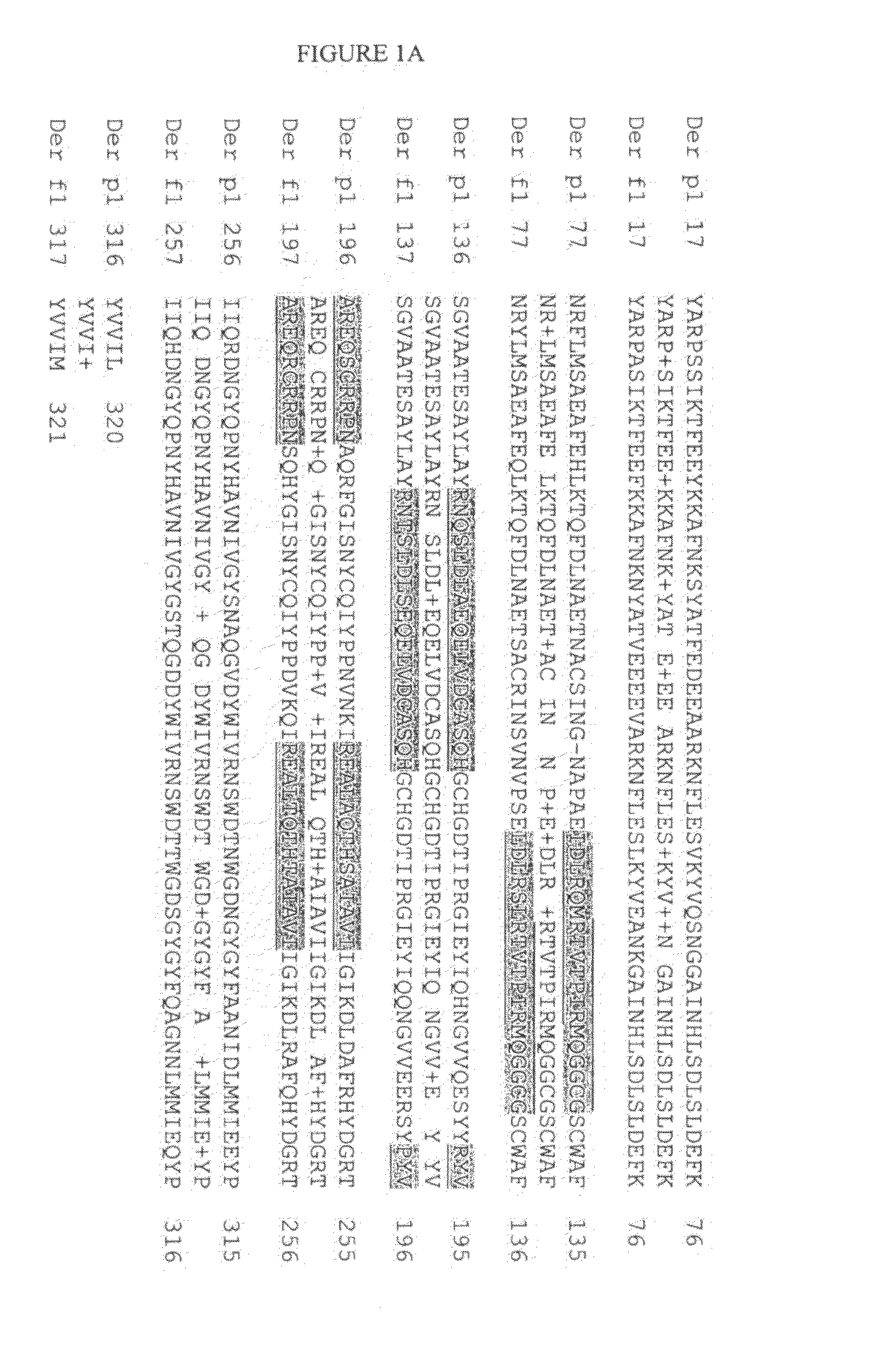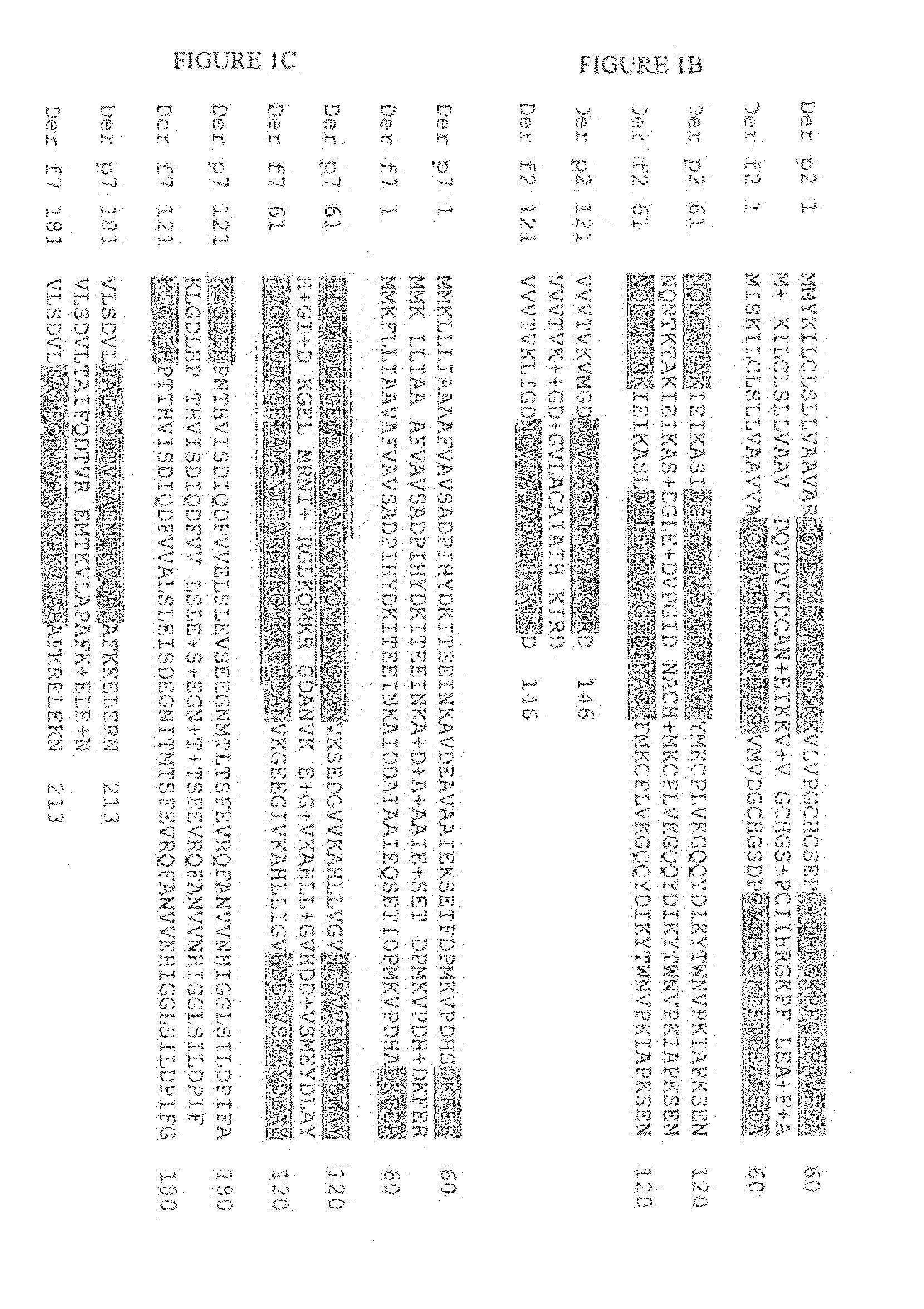Peptide for vaccine
a technology of peptides and vaccines, applied in the field of peptides for vaccines, can solve the problems of ineffective vaccination in inducing immunological responses and risk of adverse reactions, and achieve the effect of broad coverage of efficacy and broad utility
- Summary
- Abstract
- Description
- Claims
- Application Information
AI Technical Summary
Benefits of technology
Problems solved by technology
Method used
Image
Examples
example 1
MHC Class II Binding Search
[0218]The aim of this study is to identify a distinct panel of peptides with strong affinities for the seven most common human MHC Class II HLA-DRB1* allotypes (covering in total around 63% of the allotypes found in the average Caucasian population). In order to identify binding peptides in the House Dust Mite (HDM) allergens, Der p 1, Der p 2 and Der p 7, in vitro binding assays have been performed on a subset of peptides from these allergenic proteins. Peptides for testing in the binding assays were initially identified by an in silico approach known as “peptide threading” (carried out by Biovation, Ltd., Aberdeen, Scotland, UK). This is a bioinformatic analysis of consecutive peptides from a sequence for the potential to be accommodated within the binding groove of MHC class II HLA-DR molecules. This subset of peptides was pre-screened for solubility in an aqueous, acidic milieu and a final panel of 44 peptides selected for testing in an in vitro MHC Cl...
example 2
Homology Search
[0226]The sequences of each of the 24 peptides identified above as MHC Class II-binding were used to probe the sequence of the alternative protein in the dust mite allergen group from which the parent sequence derived. For example, peptide HDM01 in Table 3A is from Der p 1, therefore the sequence of HDM01 was used to probe for a homologous sequence in Der f 1. The same practice was applied for all 24 peptides identified above. The peptides identified in Example 1 and Example 2 are shown in Tables 4 to 6.
TABLE 4PeptideResiduesin TableParentinSEQ ID3A / BmoleculeSequenceparentNO:HDM01Der p 1IDLRQMRTVTPIR112-1241Der f 1LDLRSLRTVTPIR113-12525HDM02Der p 1RTVTPIRMQGGCG118-1302Der f 1RTVTPIRMQGGCG119-13126HDM03CDer p 1RNQSLDLAEQELVDCASQH149-1673Der f 1RNTSLDLSEQELVDCASQH150-16827HDM06Der p 1RYVAREQSCRRPN193-2054Der f 1PYVAREQRCRRPN194-20628HDM09ADer p 1REALAQTHSAIAVI226-2395Der f 1REALTQTHTAIAVI227-24029
TABLE 5PeptideResidues in TableParentinSEQ ID3A / BmoleculeSequenceparentNO:...
example 3
MHC Class II Binding Search
[0228]The aim of this study is to identify a distinct panel of peptides with strong affinities for the seven most common human MHC Class II HLA-DRB1* allotypes (covering in total around 63% of the allotypes found in the average Caucasian population). In order to identify binding peptides in the major House dust mite allergens Der p 1, Der p 2 and Der p 7. Peptides were identified by an in silico approach known as “peptide threading” using the commercially available EpiMatrix algorithm (EpiVax Inc.) This is a bioinformatic analysis of peptides from a sequence for the potential to be accommodated within the binding groove of MHC class II HLA-DR molecules. EpiMatrix is a matrix-based algorithm that ranks 10 amino acid long segments, overlapping by 9 amino acids, from any polypeptide sequence by estimated probability of binding to each of the selected MHC molecules. (De Groot et al., AIDS Research and Human Retroviruses 13:539-41 (1997)). The procedure for dev...
PUM
| Property | Measurement | Unit |
|---|---|---|
| Fraction | aaaaa | aaaaa |
| Fraction | aaaaa | aaaaa |
| Fraction | aaaaa | aaaaa |
Abstract
Description
Claims
Application Information
 Login to View More
Login to View More - Generate Ideas
- Intellectual Property
- Life Sciences
- Materials
- Tech Scout
- Unparalleled Data Quality
- Higher Quality Content
- 60% Fewer Hallucinations
Browse by: Latest US Patents, China's latest patents, Technical Efficacy Thesaurus, Application Domain, Technology Topic, Popular Technical Reports.
© 2025 PatSnap. All rights reserved.Legal|Privacy policy|Modern Slavery Act Transparency Statement|Sitemap|About US| Contact US: help@patsnap.com



